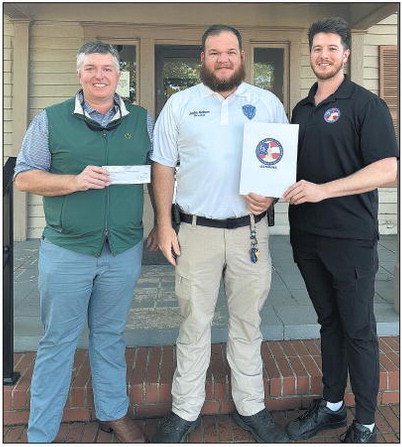Omicron and Flu Deal Double Punch
Just when we thought we might be seeing a lot less of COVID- 19 in 2022, a new variant has moved in at record speed and with record infection rates. And, to complicate matters, the flu season is high gear.
Georgia Department of Health (GDPH) tracking maps are showing deep crimson areas of concentration across Georgia where the coronavirus, presumably omicron, has swept through in the last few days. The virus is emerging in Toombs and surrounding counties but is nowhere near its peak here, according to health officials.
The good news is that while this virus is highly contagious, it is of short duration and generally considered less dangerous than its predecessors for most of the population. Unlike delta, which preyed on a younger age group, the target population continued from page
for omicron seems to be across the board.
“Where we are right now (with this variant), the area of Georgia above Macon is really on fire with omicron. Certainly, because the bulk of the population is in that region, it puts Georgia at 90% (testing positivity) for the omicron variant,” said Dr. Karen McColl, Vice President of Medical Affairs and Chief Medical Officer at Memorial Health Meadows Hospital in Vidalia.
“When you look at (the situation) county by county, the area that we live in is starting to see an uptick for percent positive tests for COVID. We are starting to see that gradual, every day increase in positive testing,” McColl noted, adding, “We are not anywhere near where we were back in the summer (with delta), but we know that the variant will soon come our way. By the end the end of the month, we anticipate this region of Georgia will have a much higher concentration of positive COVID testing, and it appears the majority of COVID out there right now is omicron.”
McColl said, for the past five weeks, Meadows has had from one to three in-patients with the virus, but has not yet had any deaths due to COVID in the past month. “Well over 70% of those patients hospitalized with COVID within the past month are unvaccinated. I can think of one patient who was vaccinated with two shots that has been hospitalized with COVID over the past four weeks. So the bulk of patients requiring hospitalization are those who are unvaccinated,” McColl said.
She said that it does appear that there is protection against the variant for those who have received two shots of Pfizer and/or Moderna with a booster after six months from the last vaccination. “Certainly, we are still recommending to the community and to folks who are delaying a decision about being vaccinated, that we think vaccinations with boostering are the most protective way against severe infection, hospitalization and/ or death from any type of COVID,” McColl emphasized.
She noted that the hospital is seeing equal hospitalizations, if not more, of patients with the flu. In the past two weeks, flu admissions have been steadily climbing. “Flu is present and that is another reason why masking is protective; it not only helps decrease transmission of COVID but also flu.” McColl said, according to the information she has seen so far, the vaccine administered by health care providers seems to be appropriate for the strain of flu that is most prevalent this season. “Flu shots will help in a majority of cases but there seems to be a virulence for some strains that causes severe illness, particularly with the elderly or the immunocompromised with underlying respiratory problems like COPD, asthma, and emphysema.” McColl noted that while omicron appears to be less severe than its predecessors, “what we are seeing is the incidence of being exposed to getting symptoms is much shorter. Symptoms like a sore throat, cough, fever, seem to show up in 24 to 48 hours from exposure. Previously, with the other forms of COVID, it would take up to four to five days for symptoms to develop.”
Because the symptoms of omicron are similar to those of flu and the common cold, the only way to know whether omicron has been contracted is by testing. This has substantially increased the demand for clinical testing, and home testing kits are flying off the shelves of local pharmacies.
“We are not recommending that people come to the emergency department for testing,” McColl said. Meadows has maintained its drive-through, GDPH-sponsored testing site throughout the health pandemic. The clinic is open Monday through Friday, 10 a.m. to 5 p.m., and on Saturdays, 9 a.m. until noon. Results are not immediately available with these PCR tests, which are sent off to labs, but GDPH will call participants with test results.
The Meadow’s community vaccination site is operational five days a week at the Lucy Pierson building on Meadows Lane. First and second Pfizer and Moderna vaccinations and boosters are available. For an appointment, call 912-535-SAFE. The GDPH is also continuing to provide COVID and flu vaccinations, and private clinics are providing the same services.
“We are recommending that folks who got a single shot of Johnson and Johnson be boostered with Pfizer and Moderna,” McColl said.
Regarding protocol for those who believe they have been exposed to omicron, McColl advised quarantining until test results are received even if asymptomatic. For those who test positive, quarantining for four or five days is recommended. “Those who have symptoms should quarantine for five days and wear a mask for an additional five days.”
On December 29, 2021, Georgia set a new single-day record for the number of positive COVID positive cases and as the omicron variant continues its spread. On this date, GDPH reported 19,124 PCR and antigen positives. This shatters the previous record set on January 8, 2021, of 13,296.
Reported tests are also at an all-time high. There were more than 56,000 PCR tests reported on December 29 alone, which breaks the old record of just over 52,000. Of those tests, the GPDH said nearly 14,000 or just over 24% were positive.
The 7-day average for PCR positivity is at 21.70%, according to GDPH data. Current hospitalizations continue to climb with now more than 2,500 COVID-19 patients reported in Georgia hospitals by the GDPH, a high that hasn't been seen since the start of October.
On the National Front The omicron variant, which accounts for more than 73% of new COVID- 19 infections in the nation and has been canceling major events and forcing schools to go virtual.
Most of the U.S. is in the red, showing high rates of transmission. Northern states such as New York, Illinois, Wisconsin as well as Florida, Georgia, Alabama are among areas hardest hit.Bottom of Form Despite a year of calls from public health experts to get vaccinated and boosted, only about 62% of the U.S. population is fully vaccinated, according to data from the U.S. Centers for Disease Control and Prevention. About 33.4% of those who are fully vaccinated have received their booster doses, the data shows. Child hospitalizations have also jumped, with some hospitals reporting some of the highest numbers they've seen since the pandemic's start. Health officials said the virus is not specifically targeting children this time, but because more virus is now circulating in communities, it's more likely that more children will get infected as well. Those pediatric numbers are expected to get worse as schools reopen, especially in areas of high transmission. In Georgia, three large Atlanta-area school districts will be starting class remotely.
As the omicron coronavirus variant accounts for the majority of new cases, the CDC is altering its medications and defense against the virus. The FDA authorized on December 22 the use of Pfizer's Paxlovid, a series of pills, taken at home that prevent nearly 90% of severe COVID-19 among those at high risk. On December 23, the Food and Drug Administration authorized use of a second antiviral, molnupiravir, which appears to prevent progression to severe disease about 30% of the time. 'As we face omicron, the nation's medicine cabinet of treatments gives us more options to protect the American people,' said Jeff Zients, the White House Coronavirus Response Coordinator. 'We have tools to keep people safe and we will continue to use them. The demand of molnupiravir is coming from all states. CDC continues to recommend wearing a mask in public indoor settings in areas of high community transmission, regardless of vaccination status.






